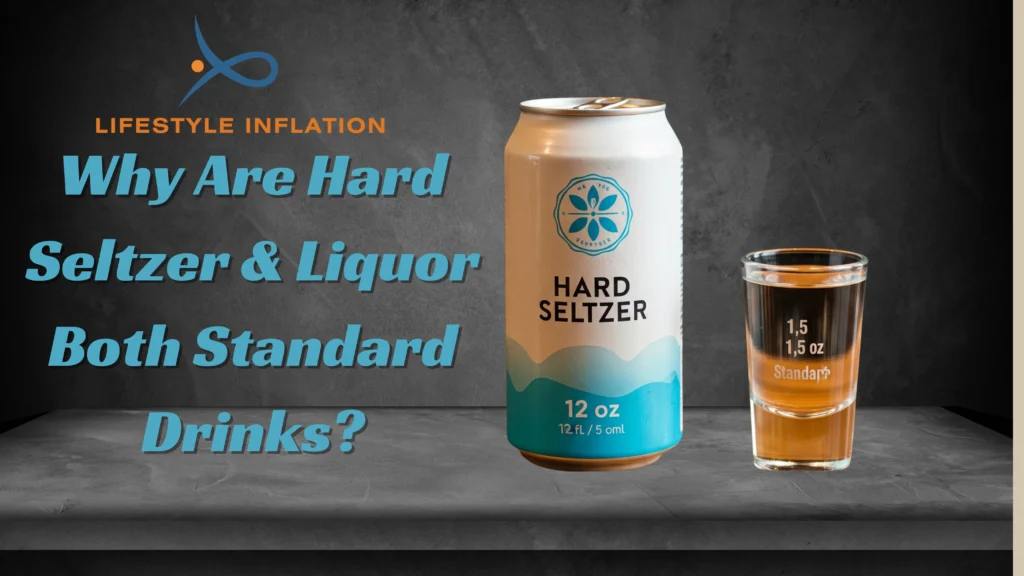Understanding why a 12 ounces of hard seltzer and 1.5 ounces of liquor both count as a standard drink is key to promoting responsible drinking habits and avoiding binge drinking risks. At first glance, these beverages appear vastly different in volume and form. However, when it comes to alcohol impact on the body, it’s not about how much you drink in size but how much ethanol per drink it contains. This article explores the standard drink definition, the science behind ethanol content, and why drink size vs alcohol content matters more than you think.
What Is a Standard Drink and Why Does It Matter?
A standard drink in the United States is a beverage that contains about 14 grams of pure alcohol. This definition is provided by the Centers for Disease Control and Prevention (CDC) and the National Institute on Alcohol Abuse and Alcoholism (NIAAA). The standard drink definition helps people keep track of their drinking across different types of alcoholic beverages.
The concept of a standard drink is essential in understanding alcohol consumption guidelines and following responsible drinking guidelines. It helps avoid confusion when comparing various drinks, like a shot of liquor versus a glass of wine or a can of beer. Knowing what qualifies as a standard drink promotes alcohol awareness education and enables smarter choices when it comes to health and safety.
How Ethanol Content Determines a Standard Drink
Although drinks differ in size, color, and flavor, they can be equal in alcohol strength based on their ethanol content. For example, 12 ounces of hard seltzer at 5% ABV (Alcohol By Volume) and 1.5 ounces of liquor at 40% ABV both contain about 14 grams of ethanol, which is equal to one standard drink.
This concept of pure alcohol equivalency is what makes it possible to classify these different beverages under the same category. Whether you drink beer, wine, or spirits, what matters is the amount of ethanol per drink, not the volume of the drink itself. The body metabolizes ethanol the same way, regardless of its source, which is why comparison of drink strengths based on ethanol helps ensure safe alcohol consumption levels.
Standard Drink Size Comparison: Hard Seltzer vs. Liquor
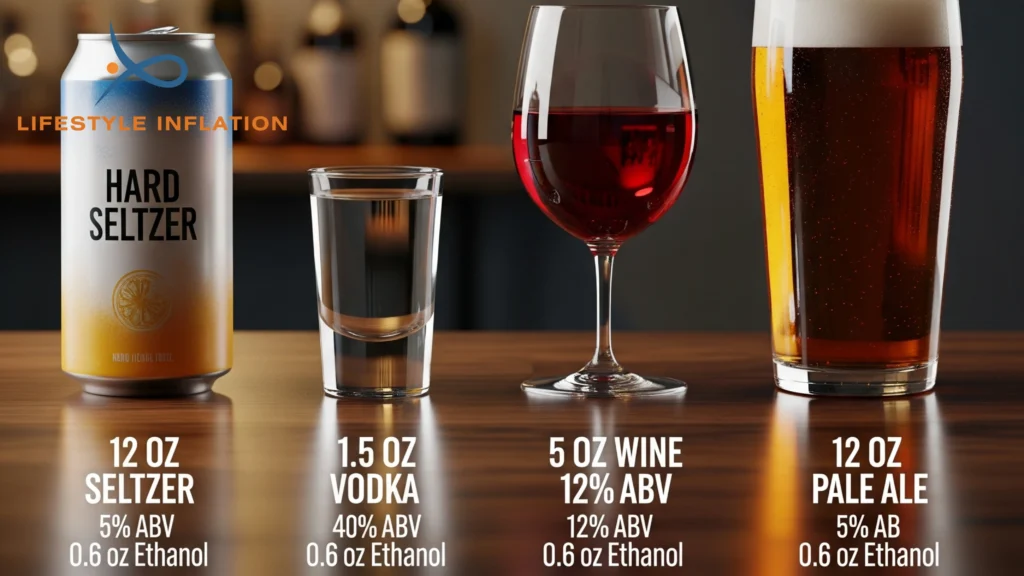
Let’s break down the standard drink size comparison between hard seltzer and liquor. A standard 12-ounce can of hard seltzer with 5% ABV hard seltzer typically contains about 14 grams of pure alcohol. On the other hand, a 1.5 ounces of liquor such as vodka or whiskey at 40% ABV holds roughly the same amount of ethanol.
| Drink Type | Volume | ABV | Ethanol Content |
|---|---|---|---|
| Hard Seltzer | 12 oz | 5% | 14 grams |
| Liquor | 1.5 oz | 40% | 14 grams |
| Beer | 12 oz | 5% | 14 grams |
| Wine | 5 oz | 12% | 14 grams |
This equivalence might surprise some people who assume that a shot is stronger than a full can of seltzer. But based on standard drink charts and data from the NIAAA drinking guidelines, both contain the same quantity of alcohol. This clarity is vital for people trying to follow CDC alcohol recommendations and make informed choices.
Understanding Alcohol by Volume (ABV) and Its Impact
ABV (Alcohol by Volume) tells you what percentage of a beverage’s liquid is pure alcohol. It plays a key role in measuring alcohol intake accurately. For example, a drink with a 5% ABV means that 5% of the liquid is pure alcohol. The rest is water, flavorings, or other ingredients.
Understanding ABV is central to comparing drinks. Even if one drink is smaller, it may have a higher ABV, making it equal in strength to a larger, weaker drink. This knowledge can help you follow health recommendations for drinking and maintain responsible alcohol consumption.
Why 12 oz of Hard Seltzer Equals One Standard Drink
Hard seltzers have become popular for their light flavor and lower calorie count. But what many don’t realize is that a 12 ounces of hard seltzer with 5% ABV contains the same amount of ethanol as a 1.5 oz shot of 40% ABV liquor. That’s about 14 grams of pure alcohol.
This means even trendy, seemingly light drinks contribute to your alcohol intake just as much as a shot. Brands often print ABV clearly on cans, which makes them easier to track when using alcohol calculator apps or drink tracking tools. The clear labeling supports alcohol awareness education and helps people stick to safe alcohol consumption levels.
Why 1.5 oz of Liquor Is Considered One Standard Drink
Spirits like vodka, whiskey, tequila, and rum usually have around 40% ABV. A 1.5 ounces of liquor at this strength contains about 14 grams of ethanol, aligning it with the standard drink definition. Despite being smaller in volume, its higher concentration makes it just as potent.
This equivalence is crucial for responsible drinking habits. People often assume that one shot equals one drink—but when cocktails contain multiple shots, the number of standard drinks in cocktails increases. This increases the risk of binge drinking if not tracked properly.
How to Track Standard Drinks with Accuracy
Many people underestimate how much they drink. Visual cues like glass size or drink color can be misleading. That’s why using alcohol tracking tools or drink calculator apps is recommended. These apps help calculate ethanol per drink based on ABV and volume.
If a person drinks a cocktail with 2 shots of liquor, that’s two standard drinks. A pint of strong beer may also equal 1.5 to 2 drinks depending on the ABV. These calculations help avoid exceeding NIAAA daily limits and improve your understanding of alcohol units.
CDC and NIAAA Guidelines for Responsible Drinking
The CDC alcohol recommendations and NIAAA daily limits serve as critical benchmarks for safe drinking. For men, the guideline is no more than two standard drinks per day. For women, it’s just one. These limits are based on the effects of 14 grams of ethanol per standard drink.
Following these limits helps reduce the risks of liver disease,blocked arteries,addiction, and impaired judgment. It also aligns with goals set by wellness platforms, healthcare providers, and public safety organizations. These responsible drinking guidelines are not just for heavy drinkers but for everyone.
Avoiding Common Misconceptions About Serving Sizes
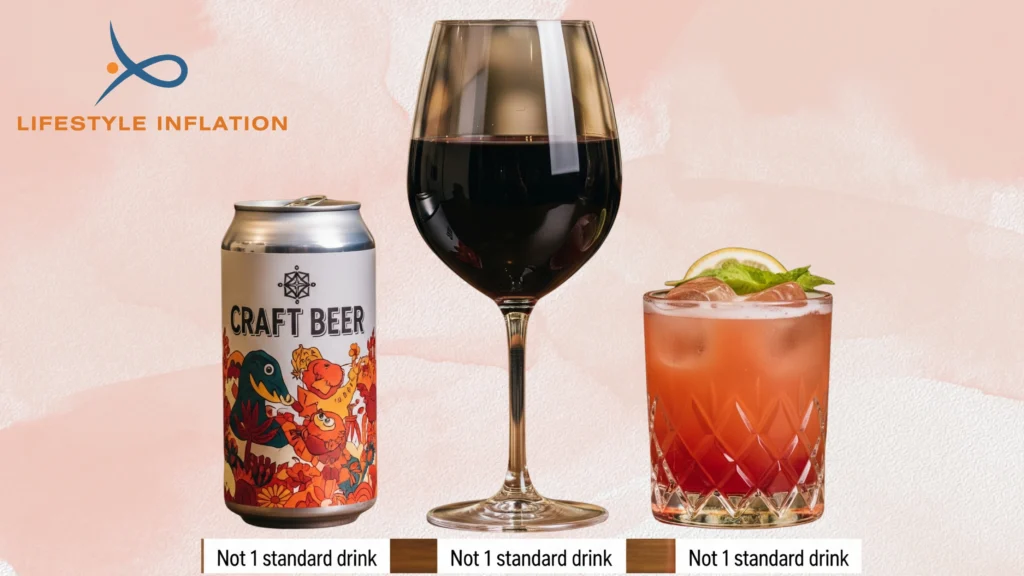
Many people wrongly believe that one glass of wine or one cocktail equals one drink. In reality, a mixed drink may contain up to three standard drinks, depending on how much liquor is used. Similarly, a tall can of craft beer or strong seltzer can exceed the 14-gram ethanol limit.
Here’s a table to clear up common misconceptions:
| Beverage | Volume | ABV (%) | Approx. Standard Drinks |
| Craft Beer | 16 oz | 7% | 1.6 |
| Tall Seltzer | 16 oz | 6% | 1.3 |
| Homemade Margarita (2 shots) | ~3 oz liquor | 40% | 2 |
| Standard Wine Glass | 8 oz | 12% | 1.6 |
Being unaware of the true alcohol content in a beverage can lead to unintentional binge drinking. Knowing the standard drink definition and using drink tracking apps can help prevent this. Tables and charts provided by the CDC and NIAAA make it easier to visualize what a true standard drink looks like.
Global Differences in Standard Drink Measurements
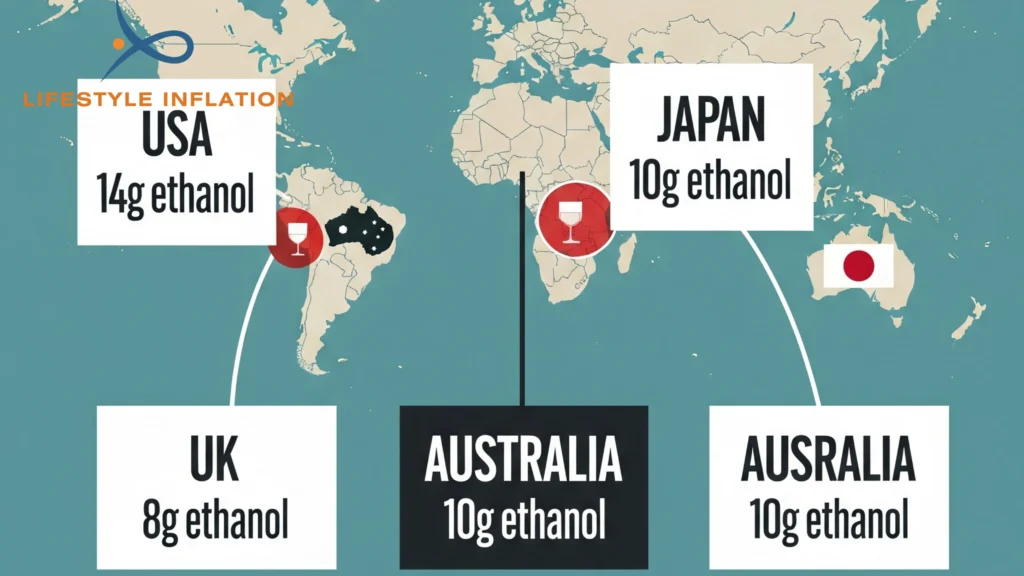
Not every country uses the same measurement for a standard drink. The U.S. uses 14 grams of pure alcohol, while the U.K. uses 8 grams, Australia 10 grams, and Japan 19.75 grams. These variations create confusion when traveling or reading international labels.
Below is a table showing the differences:
| Country | Grams of Ethanol per Standard Drink |
| United States | 14 grams |
| United Kingdom | 8 grams |
| Australia | 10 grams |
| Japan | 19.75 grams |
Understanding these global alcohol standards is key for international travelers or those comparing imported beverages.
Why Knowing Your Standard Drink Count Matters
Knowing how many standard drinks you’ve had is crucial for blood alcohol content estimation, decision-making, and health. For example, someone who drinks three glasses of wine may have consumed 3–4 standard drinks, not one.
Tracking your drink count helps avoid impaired driving, supports your fitness goals, and ensures you stay within safe driving limits. It’s also useful for those using wellness platforms to monitor overall health.
How Standard Drinks Help Prevent Overconsumption
Educating yourself about standard drinks reduces the likelihood of overconsumption and helps you recognize when you’re nearing your limit. This awareness is a powerful tool in avoiding addiction and long-term damage to your health.
The standard drink system simplifies alcohol management, makes it easier to follow alcohol consumption guidelines, and fosters responsible alcohol consumption practices. It’s not about fear—it’s about being informed and empowered.
Mixed Drinks, Cocktails, and Their Standard Drink Equivalents
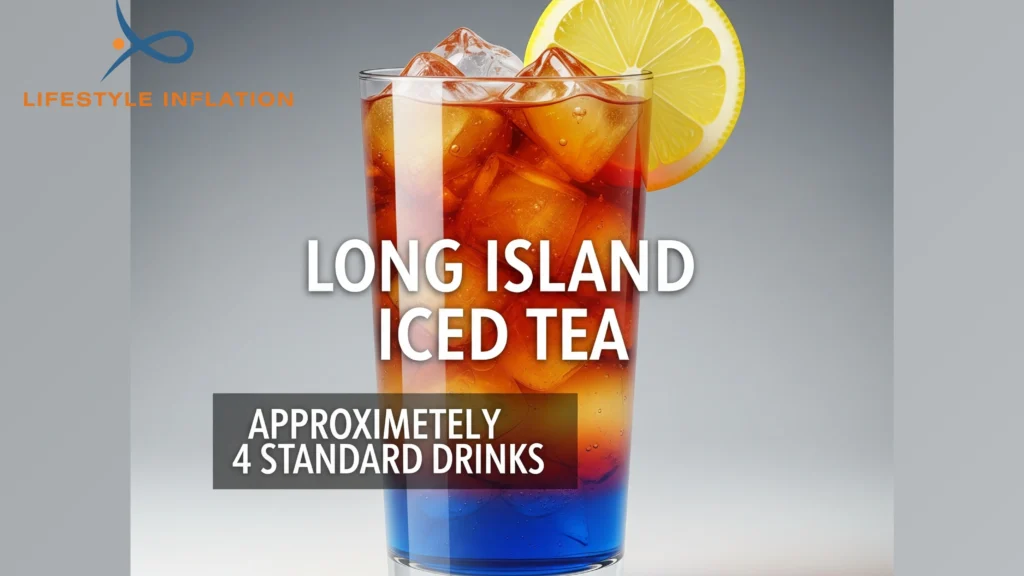
Cocktails are often misunderstood in terms of alcohol strength. A Margarita may contain two shots of tequila, making it equivalent to two standard drinks. A Long Island Iced Tea could hold up to four shots, pushing it to four standard drinks or more.
Understanding cocktail alcohol content is essential for measuring alcohol intake accurately. Bartenders rarely serve by ethanol calculations, so drinkers must stay informed. Here’s a quick look at cocktail equivalents:
| Cocktail | Typical ABV (%) | Approx. Standard Drinks |
| Margarita | 25% | 2 |
| Long Island Iced Tea | 22–28% | 3–4 |
| Martini | 30% | 2 |
| Mojito | 15% | 1.5 |
Understanding the standard drinks in cocktails helps maintain safe alcohol consumption levels and improves your ability to track your drinking realistically.
Final Thoughts
Understanding why 12 ounces of hard seltzer and 1.5 ounces of liquor are both counted as a standard drink empowers you to drink smarter—not just less. It’s not the size of the glass but the 14 grams of pure alcohol inside that matters most. Whether you’re sipping cocktails or cracking open a can, recognizing ethanol content, tracking your intake with alcohol calculator apps, and following CDC alcohol recommendations are vital steps toward protecting your health and well-being.
By learning how to read ABV (alcohol by volume), comparing drink strengths accurately, and staying within NIAAA daily limits, you build a safer relationship with alcohol. From backyard BBQs to nights out, smart choices begin with alcohol awareness education and a solid grasp of the standard drink definition. Cheers to being informed—and drinking responsibly.
FAQ’s
Why are a 12 oz hard seltzer and a 1.5 oz liquor both standard drinks?
Because both contain around 14 grams of pure alcohol, making them equal in ethanol content even though their volume and form are different.
Is 12 ounces of hard seltzer a standard drink?
Yes, 12 oz of hard seltzer at 5% ABV equals one standard drink as it contains about 14 grams of ethanol, per U.S. alcohol guidelines.
What has more alcohol, a 12 oz beer or a 1.5 oz shot of liquor?
Both contain about 14 grams of pure alcohol, so they’re considered equal in alcohol content. However, the liquor is more concentrated, while the beer spreads that alcohol over a larger volume.
Can I get drunk from just one standard drink?
It depends on your body weight, metabolism, and tolerance, but one standard drink may cause slight impairment, especially in those sensitive to alcohol or drinking on an empty stomach.
Do different types of alcohol affect you differently?
Even though the ethanol content is the same, mixers, carbonation, and how quickly you drink can affect how fast alcohol hits your system, making some drinks feel stronger than others.

